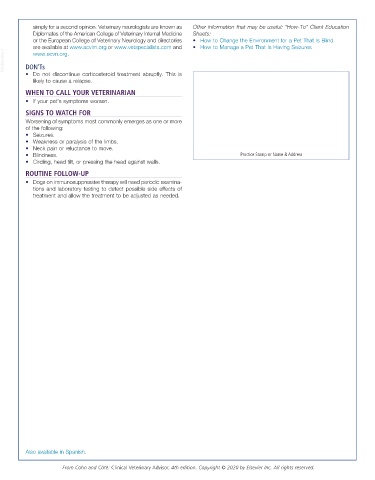Page 3078 - Cote clinical veterinary advisor dogs and cats 4th
P. 3078
simply for a second opinion. Veterinary neurologists are known as Other information that may be useful: “How-To” Client Education
Diplomates of the American College of Veterinary Internal Medicine Sheets:
or the European College of Veterinary Neurology and directories • How to Change the Environment for a Pet That Is Blind
are available at www.acvim.org or www.vetspecialists.com and • How to Manage a Pet That Is Having Seizures
VetBooks.ir DON’Ts
www.ecvn.org.
• Do not discontinue corticosteroid treatment abruptly. This is
likely to cause a relapse.
WHEN TO CALL YOUR VETERINARIAN
• If your pet’s symptoms worsen.
SIGNS TO WATCH FOR
Worsening of symptoms most commonly emerges as one or more
of the following:
• Seizures.
• Weakness or paralysis of the limbs.
• Neck pain or reluctance to move.
• Blindness. Practice Stamp or Name & Address
• Circling, head tilt, or pressing the head against walls.
ROUTINE FOLLOW-UP
• Dogs on immunosuppressive therapy will need periodic examina-
tions and laboratory testing to detect possible side effects of
treatment and allow the treatment to be adjusted as needed.
Also available in Spanish.
From Cohn and Côté: Clinical Veterinary Advisor, 4th edition. Copyright © 2020 by Elsevier Inc. All rights reserved.

